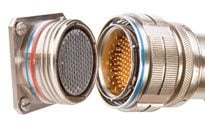Connectors Defined
At its most basic level, a connector is a simple mechanical device that allows an electrical connection between two systems to be connected and disconnected with ease. A versatile connector is capable of providing a mix of signal, power, and data (in the form of fiber optic, multiple wires, and various cable types) in a single connector package. It is a lot easier to seal and protect a single multi-function cable than a multitude of single function cables and wires, which add engineering complexity to a design. The exploded views of a receptacle and plug below show the components of a typical cylindrical solder connector and should provide a basic overview.

Receptacle Assembly

- Cable Bushing – A rubber bushing that provides additional environmental sealing and protects the wire jacket from cable clamp friction.
- Mounting Bracket – A metal bracket with four captive locking nuts used to securely mount flanged receptacles to a panel.
- Mounting Gasket – A neoprene seal that fills the space between the connector flange and the equipment panel.
- Accessory Threads – Coupling threads on the rear of shells used to accept accessories such as backshells.
- Mounting Flange – Flat metal extension around the periphery of a shell used to grip and mount the receptacle to a panel by fasteners through the mounting holes.
- Receptacle – Counterpart connector that mates to the plug. Receptacles usually mount to a panel or enclosure.
- Contacts – The conductive element in a connector that makes the connection between the wire and the mating connector’s counterpart contact for the purpose of transferring electrical energy. Socket contacts are female; pin contacts are male.
- Insert – A dielectric insulator in a connector that maintains the contacts in their proper arrangement and electrically insulates them from each other and from the shell.
- Sealing Screws – Screws with an O-ring beneath the head that effectively seal the mounting holes on the enclosure.
Plug Assembly

- Protective Cover – A cover used in place of a mating connector to seal against dirt and moisture. Protective covers are secured to the connector by a captive chain.
- Plug – Connector that mates into a receptacle. Plugs mount at the end of loose cables.
- Shell – The outer casing of a connector that houses and protects the inserts and contacts. Keyways on the shell help to properly orient the connector prior to coupling.
- O-Ring – A rubber ring placed around the periphery of a plug’s shell to form an environmental seal when mated.
- Coupling Ring – The knurled or fluted free-spinning ring on a plug that couples and locks onto the receptacle shell.
- Sealing Grommet – A soft rubber seal used on a multiple-contact connector to environmentally seal the individual wires against moisture, dirt, or air.
- Compression Cup – A rigid plastic or metal cup that provides compression on the grommet to seal wires as the backshell is tightened on the connector shell.
- Backshell – Any accessory that attaches to the rear of a connector. Most backshells provide environmental sealing and/or strain relief for wires or cables.
- Cable Clamp – An accessory that tightens over a cable or wire bundle at the rear of the plug or receptacle to provide mechanical support and strain relief to the cable.




